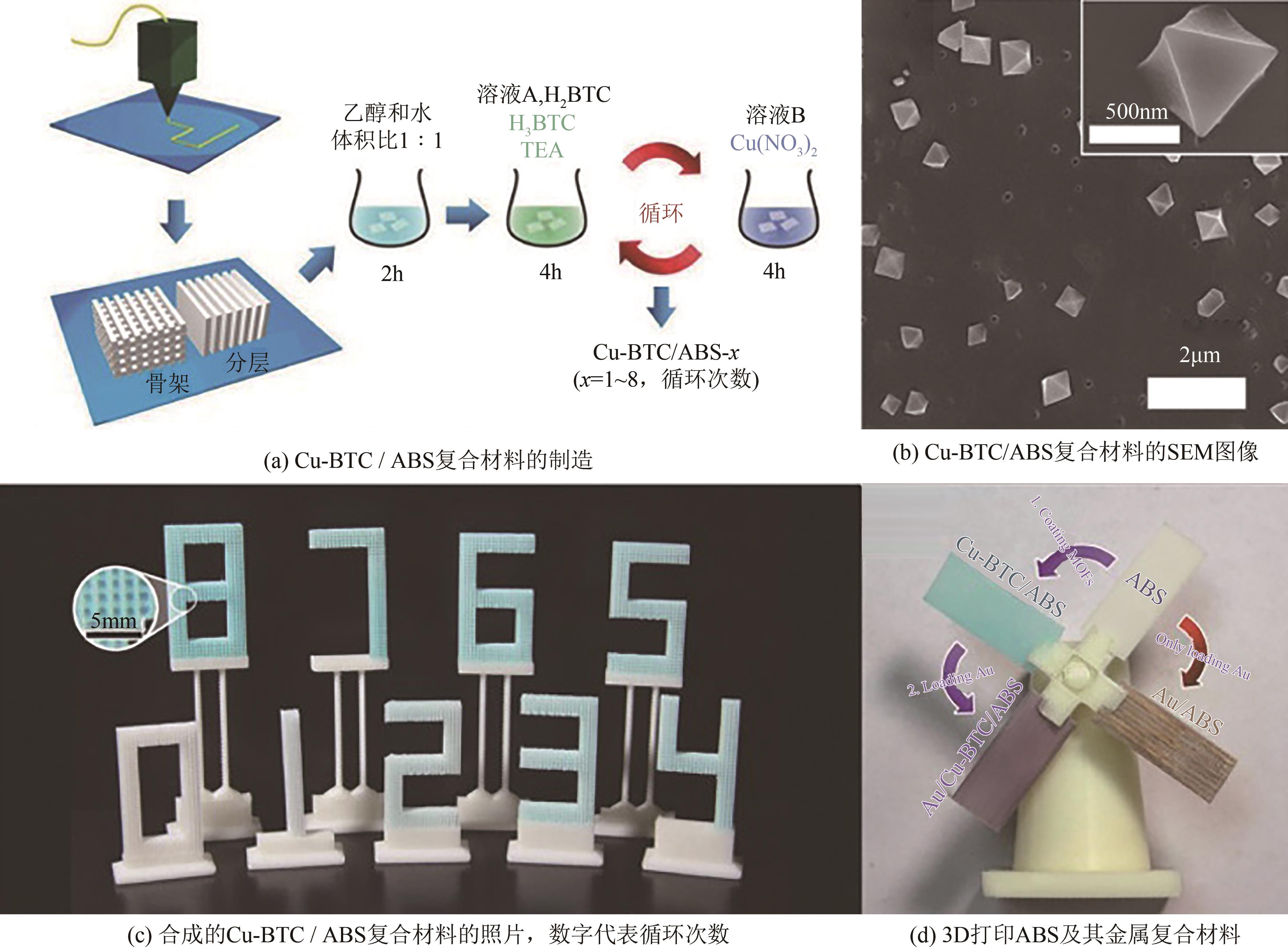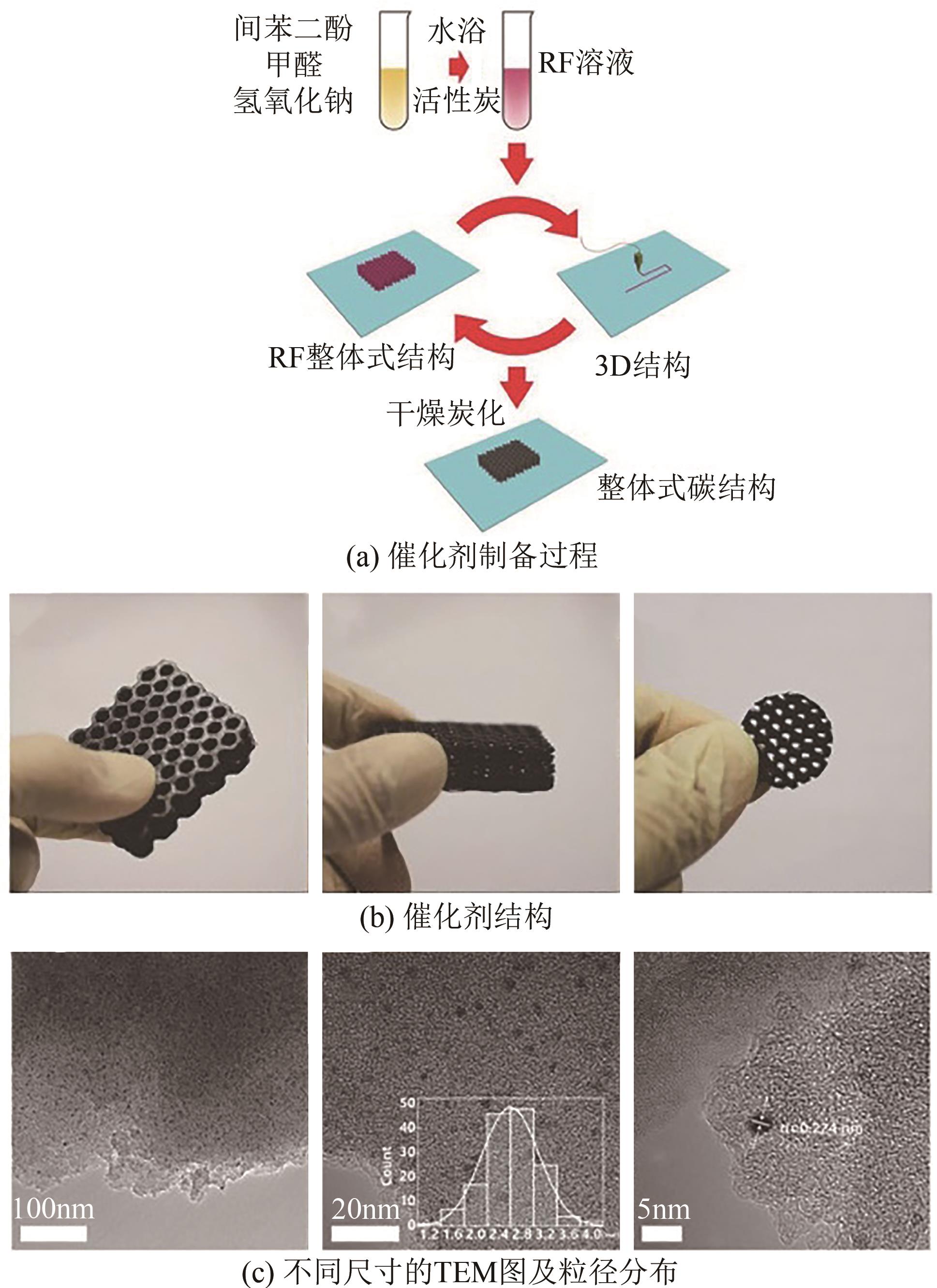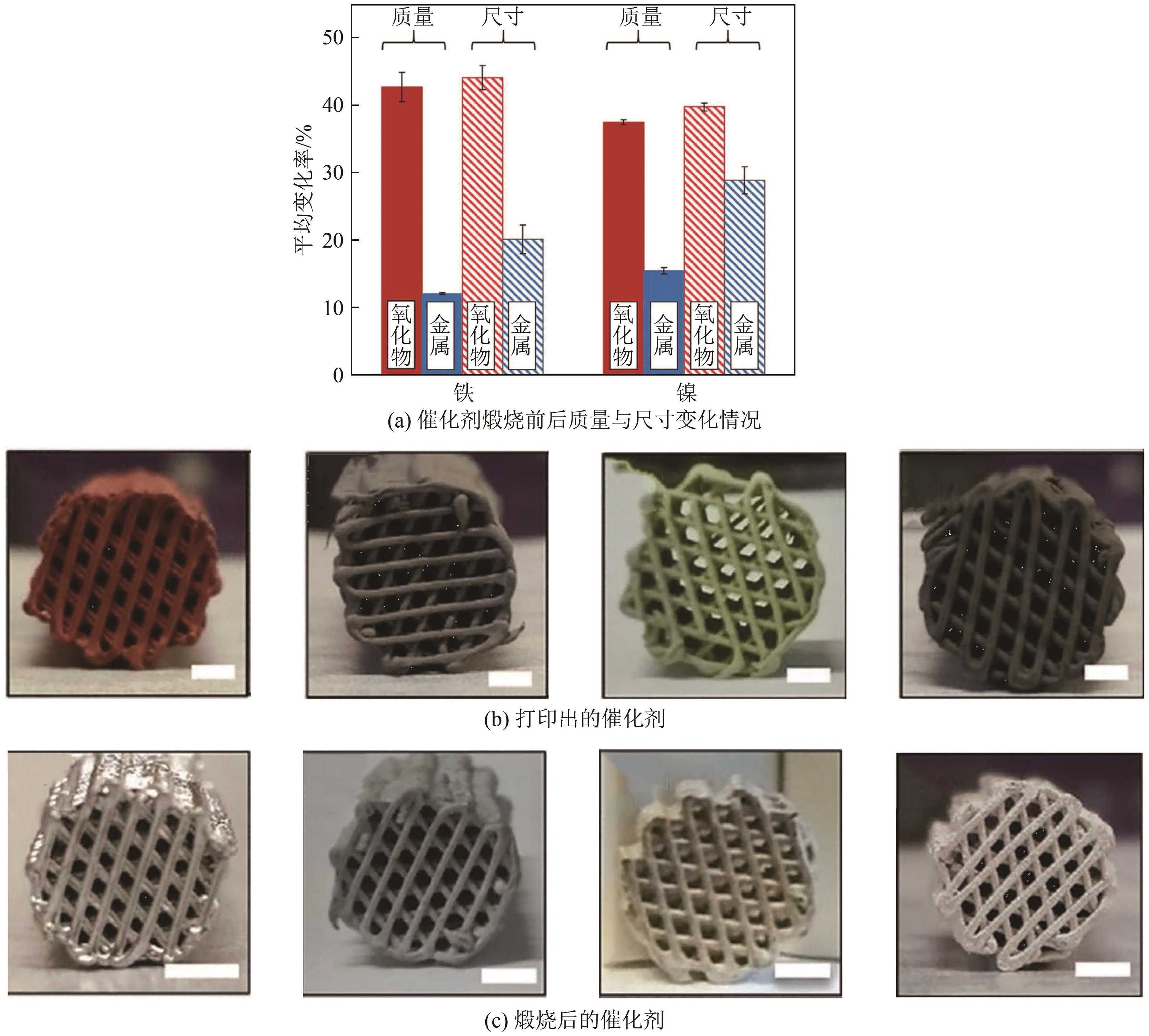Chemical Industry and Engineering Progress ›› 2023, Vol. 42 ›› Issue (8): 3956-3964.DOI: 10.16085/j.issn.1000-6613.2023-0150
Previous Articles Next Articles
Progress of the development and application of 3D printing catalyst
WU Haibo1,2( ), WANG Xilun2, FANG Yanxiong1, JI Hongbing2,3(
), WANG Xilun2, FANG Yanxiong1, JI Hongbing2,3( )
)
- 1.Faculty of Chemical Engineering and Light Industry, Guangdong University of Technology, Guangzhou 510006, Guangdong, China
2.Huizhou Research Institute of Sun Sat-sen University, Huizhou 516081, Guangdong,China
3.Institute of Green Petroleum Processing and Light Hydrocarbon Conversion, College of Chemical Engineering, Zhejiang University of Technology, Hangzhou 310014, Zhejiang, China
-
Received:2023-02-07Revised:2023-07-01Online:2023-09-19Published:2023-08-15 -
Contact:JI Hongbing
3D打印催化材料开发与应用进展
吴海波1,2( ), 王希仑2, 方岩雄1, 纪红兵2,3(
), 王希仑2, 方岩雄1, 纪红兵2,3( )
)
- 1.广东工业大学轻工化工学院,广东 广州 510006
2.中山大学惠州研究院,广东 惠州 516081
3.浙江工业大学化学工程学院,浙江绿色石化与轻烃转化研究院,浙江 杭州 310014
-
通讯作者:纪红兵 -
作者简介:吴海波(1985—),男,博士研究生,高级工程师,研究方向为结构化催化剂。E-mail:wu.haibo08@163.com。 -
基金资助:国家重点研发计划“纳米科技”重点专项(2020YFA0210900);广东省“珠江人才计划”本土创新科研团队项目(2017BT01C102);先进能源科学与技术广东省实验室团队项目(DJLTF0410);广东省基础与应用基础研究基金(2022A1515140008)
CLC Number:
Cite this article
WU Haibo, WANG Xilun, FANG Yanxiong, JI Hongbing. Progress of the development and application of 3D printing catalyst[J]. Chemical Industry and Engineering Progress, 2023, 42(8): 3956-3964.
吴海波, 王希仑, 方岩雄, 纪红兵. 3D打印催化材料开发与应用进展[J]. 化工进展, 2023, 42(8): 3956-3964.
share this article
Add to citation manager EndNote|Ris|BibTeX
URL: https://hgjz.cip.com.cn/EN/10.16085/j.issn.1000-6613.2023-0150
| 方法 | 催化剂/材料 | 优点 | 缺点 |
|---|---|---|---|
| 熔融沉积成型(FDM) | 聚合物PLA、ABS | 成本低、材料利用率高 | 精度低、打印速度慢 |
| 光固化(SLA) | 光敏树脂 | 精度较高 | 价格偏高 |
| 直接墨水书写(DIW) | 陶瓷、碳材料等 | 成本低、操作简单 | 增加后处理 |
| 选择性激光烧结(SLS) | ABS、蜡 | 工艺简单,韧性好 | 费用较高、易变形 |
| 方法 | 催化剂/材料 | 优点 | 缺点 |
|---|---|---|---|
| 熔融沉积成型(FDM) | 聚合物PLA、ABS | 成本低、材料利用率高 | 精度低、打印速度慢 |
| 光固化(SLA) | 光敏树脂 | 精度较高 | 价格偏高 |
| 直接墨水书写(DIW) | 陶瓷、碳材料等 | 成本低、操作简单 | 增加后处理 |
| 选择性激光烧结(SLS) | ABS、蜡 | 工艺简单,韧性好 | 费用较高、易变形 |
| 1 | YUAN Zijian, LIU Lu, RU Wei, et al. 3D printed hierarchical spinel monolithic catalysts for highly efficient semi-hydrogenation of acetylene[J]. Nano Research, 2022, 15(7): 6010-6018. |
| 2 | CENTI Gabriele, PERATHONER Siglinda. Novel catalyst design for multiphase reactions[J]. Catalysis Today, 2003, 79/80: 3-13. |
| 3 | ZHU Jie, WU Peiwen, CHAO Yanhong, et al. Recent advances in 3D printing for catalytic applications[J]. Chemical Engineering Journal, 2022, 433: 134341. |
| 4 | ROBBINS Spencer W, Sai Hiroaki, DISALVO Francis J, et al. Monolithic gyroidal mesoporous mixed titanium-niobium nitrides[J]. ACS Nano, 2014, 8(8): 8217-8223. |
| 5 | SUN Fang, Jean-Rene ELLA-MENYE, GALVAN Daniel David, et al. Stealth surface modification of surface-enhanced Raman scattering substrates for sensitive and accurate detection in protein solutions[J]. ACS Nano, 2015, 9(3): 2668-2676. |
| 6 | GU Zhanjun, Parans PARANTHAMAN M, XU Jun, et al. Aligned ZnO nanorod arrays grown directly on zinc foils and zinc spheres by a low-temperature oxidization method[J]. ACS Nano, 2009, 3(2): 273-278. |
| 7 | Jessica CAMPOS-DELGADO, ROMO-HERRERA José Manuel, JIA Xiaoting, et al. Bulk production of a new form of sp2 carbon: Crystalline graphene nanoribbons[J]. Nano Letters, 2008, 8(9): 2773-2778. |
| 8 | LI Zuojiang, DEL CUL Guillermo D, YAN Wenfu, et al. Fluorinated carbon with ordered mesoporous structure[J]. Journal of the American Chemical Society, 2004, 126(40): 12782-12783. |
| 9 | ZHOU Xintong, ZHANG Quan, LIU Changjun. Templated synthesis of urchin-like zinc oxide particles by micro-combustion[J]. Frontiers of Chemical Science and Engineering, 2014, 8(1): 73-78. |
| 10 | CHAI Geun Seok, YOON Suk Bon, YU Jong-Sung, et al. Ordered porous carbons with tunable pore sizes as catalyst supports in direct methanol fuel cell[J]. The Journal of Physical Chemistry B, 2004, 108(22): 7074-7079. |
| 11 | 王雪莹. 3D打印技术与产业的发展及前景分析[J]. 中国高新技术企业, 2012(26): 3-5. |
| WANG Xueying. Development and prospect analysis of 3D printing technology and industry[J]. China High-Tech Enterprises, 2012(26): 3-5. | |
| 12 | Cesar PARRA-CABRERA, ACHILLE Clement, KUHN Simon, et al. 3D printing in chemical engineering and catalytic technology: Structured catalysts, mixers and reactors[J]. Chemical Society Reviews, 2018, 47(1): 209-230. |
| 13 | HALDORAI Yuvaraj, SHIM Jae-Jin. Fabrication of metal oxide-polymer hybrid nanocomposites[J]. Organic-Inorganic Hybrid Nanomaterials, 2015, 267: 249-281. |
| 14 | WENDEL Bettina, RIETZEL Dominik, Florian KÜHNLEIN, et al. Additive processing of polymers[J]. Macromolecular Materials and Engineering, 2008, 293(10): 799-809. |
| 15 | CRIVELLO James V, REICHMANIS Elsa. Photopolymer materials and processes for advanced technologies[J]. Chemistry of Materials, 2014, 26(1): 533-548. |
| 16 | LAM C X F, MO X M, TEOH S H, et al. Scaffold development using 3D printing with a starch-based polymer[J]. Materials Science and Engineering: C, 2002, 20(1/2): 49-56. |
| 17 | KOEGLER Wendy S, GRIFFITH Linda G. Osteoblast response to PLGA tissue engineering scaffolds with PEO modified surface chemistries and demonstration of patterned cell response[J]. Biomaterials, 2004, 25(14): 2819-2830. |
| 18 | TAY B Y, ZHANG S X, MYINT M H, et al. Processing of polycaprolactone porous structure for scaffold development[J]. Journal of Materials Processing Technology, 2007, 182(1/2/3): 117-121. |
| 19 | PENG Zhonghua. Rational synthesis of covalently bonded organic-inorganic hybrids[J]. Angewandte Chemie International Edition, 2004, 43(8): 930-935. |
| 20 | HONG J I, WINBERG P, SCHADLER L S, et al. Dielectric properties of zinc oxide/low density polyethylene nanocomposites[J]. Materials Letters, 2005, 59(4): 473-476. |
| 21 | LEE Jinhong, Kyung-Hee KO, PARK Byung-Ok. Electrical and optical properties of ZnO transparent conducting films by the sol-gel method[J]. Journal of Crystal Growth, 2003, 247(1/2): 119-125. |
| 22 | ZOU Hua, WU Shishan, SHEN Jian. Polymer/silica nanocomposites: Preparation, characterization, properties, and applications[J]. Chemical Reviews, 2008, 108(9): 3893-3957 |
| 23 | DEMIR Mustafa M, CASTIGNOLLES Patrice, Ümit AKBEY, et al. In-situ bulk polymerization of dilute particle/MMA dispersions[J]. Macromolecules, 2007, 40(12): 4190-4198. |
| 24 | KAHN M L, MONGE M, COLLIÈRE V, et al. Size- and shape-control of crystalline zinc oxide nanoparticles: A new organometallic synthetic method[J]. Advanced Functional Materials, 2005, 15(3): 458-468. |
| 25 | MIYAUCHI Masahiro, LI Yongjin, SHIMIZU Hiroshi. Enhanced degradation in nanocomposites of TiO2 and biodegradable polymer[J]. Environmental Science & Technology, 2008, 42(12): 4551-4554. |
| 26 | YUNG Winco K C, SUN Bo, HUANG Junfeng, et al. Photochemical copper coating on 3D printed thermoplastics[J]. Scientific Reports, 2016, 6: 31188. |
| 27 | SHI Zhennan, XU Chen, CHEN Fei, et al. Renewable metal-organic-frameworks-coated 3D printing film for removal of malachite green[J]. RSC Advances, 2017, 7(79): 49947-49952. |
| 28 | CASTLES F, ISAKOV D, LUI A, et al. Microwave dielectric characterisation of 3D-printed BaTiO3/ABS polymer composites[J]. Scientific Reports, 2016, 6: 22714. |
| 29 | SKORSKI Matthew R, ESENTHER Jake M, AHMED Zeeshan, et al. The chemical, mechanical, and physical properties of 3D printed materials composed of TiO2-ABS nanocomposites[J]. Science and Technology of Advanced Materials, 2016, 17(1): 89-97. |
| 30 | FANTINO Erika, CHIAPPONE Annalisa, ROPPOLO Ignazio, et al. 3D printing of conductive complex structures with in situ generation of silver nanoparticles[J]. Advanced Materials, 2016, 28(19): 3712-3717. |
| 31 | MICHORCZYK P, HĘDRZAK E, WĘGRZYNIAK A. Preparation of monolithic catalysts using 3D printed templates for oxidative coupling of methane[J]. Journal of Materials Chemistry A, 2016, 4(48): 18753-18756. |
| 32 | LIANG Chengdu, XIE Hong, SCHWARTZ Viviane, et al. Open-cage fullerene-like graphitic carbons as catalysts for oxidative dehydrogenation of isobutane[J]. Journal of the American Chemical Society, 2009, 131(22): 7735-7741. |
| 33 | Kyoung-Su HA, KWAK Geunjae, Ki-Won JUN, et al. Ordered mesoporous carbon nanochannel reactors for high-performance Fischer-Tropsch synthesis[J]. Chemical Communications, 2013, 49(45): 5141-5143. |
| 34 | MIDDELKOOP Vesna, SLATER Thomas, FLOREA Mihaela, et al. Next frontiers in cleaner synthesis: 3D printed graphene-supported CeZrLa mixed-oxide nanocatalyst for CO2 utilisation and direct propylene carbonate production[J]. Journal of Cleaner Production, 2019, 214: 606-614. |
| 35 | WANG Zongyuan, LIU Changjun. Preparation and application of iron oxide/graphene based composites for electrochemical energy storage and energy conversion devices: Current status and perspective[J]. Nano Energy, 2015, 11: 277-293. |
| 36 | ZHOU Xintong, LIU Changjun. Three-dimensional printing for catalytic applications: Current status and perspectives[J]. Advanced Functional Materials, 2017, 27(30): 1701134. |
| 37 | MORENO-CASTILLA C, MALDONADO-HÓDAR F J. Carbon aerogels for catalysis applications: An overview[J]. Carbon, 2005, 43(3): 455-465. |
| 38 | ZHU Cheng, LIU Tianyu, QIAN Fang, et al. Supercapacitors based on three-dimensional hierarchical graphene aerogels with periodic macropores[J]. Nano Letters, 2016, 16(6): 3448-3456. |
| 39 | RAMBO Carlos R, TRAVITZKY Nahum, GREIL Peter. Conductive TiC/Ti-Cu/C composites fabricated by Ti-Cu alloy reactive infiltration into 3D-printed carbon performs[J]. Journal of Composite Materials, 2015, 49(16): 1971-1976. |
| 40 | FRAZIER William E. Metal additive manufacturing: A review[J]. Journal of Materials Engineering and Performance, 2014, 23(6): 1917-1928. |
| 41 | QUAN Haoyuan, ZHANG Ting, XU Hang, et al. Photo-curing 3D printing technique and its challenges[J]. Bioactive Materials, 2020, 5(1): 110-115. |
| 42 | BAENA-MORENO Francisco M, Miriam GONZÁLEZ-CASTAÑO, NAVARRO DE MIGUEL Juan Carlos, et al. Stepping toward efficient microreactors for CO2 methanation: 3D-printed gyroid geometry[J]. ACS Sustainable Chemistry & Engineering, 2021, 9(24): 8198-8206. |
| 43 | ELKHATAT Ahmed M, AL-MUHTASEB Shaheen A. Advances in tailoring resorcinol-formaldehyde organic and carbon gels[J]. Advanced Materials, 2011, 23(26): 2887-2903. |
| 44 | WAN Ying, SHI Yifeng, ZHAO Dongyuan. Supramolecular aggregates as templates: Ordered mesoporous polymers and carbons[J]. Chemistry of Materials, 2008, 20(3): 932-945. |
| 45 | FARAHANI Rouhollah D, Martine DUBÉ, THERRIAULT Daniel. Three-dimensional printing of multifunctional nanocomposites: Manufacturing techniques and applications[J]. Advanced Materials, 2016, 28(28): 5794-5821. |
| 46 | TAYLOR Shannon L, JAKUS Adam E, SHAH Ramille N, et al. Iron and nickel cellular structures by sintering of 3D-printed oxide or metallic particle inks[J]. Advanced Engineering Materials,2017, 19(11):1600365. |
| 47 | TUBÍO Carmen R, AZUAJE Jhonny, ESCALANTE Luz, et al. 3D printing of a heterogeneous copper-based catalyst[J]. Journal of Catalysis, 2016, 334: 110-115. |
| [1] | ZHANG Mingyan, LIU Yan, ZHANG Xueting, LIU Yake, LI Congju, ZHANG Xiuling. Research progress of non-noble metal bifunctional catalysts in zinc-air batteries [J]. Chemical Industry and Engineering Progress, 2023, 42(S1): 276-286. |
| [2] | SHI Yongxing, LIN Gang, SUN Xiaohang, JIANG Weigeng, QIAO Dawei, YAN Binhang. Research progress on active sites in Cu-based catalysts for CO2 hydrogenation to methanol [J]. Chemical Industry and Engineering Progress, 2023, 42(S1): 287-298. |
| [3] | XIE Luyao, CHEN Songzhe, WANG Laijun, ZHANG Ping. Platinum-based catalysts for SO2 depolarized electrolysis [J]. Chemical Industry and Engineering Progress, 2023, 42(S1): 299-309. |
| [4] | YANG Xiazhen, PENG Yifan, LIU Huazhang, HUO Chao. Regulation of active phase of fused iron catalyst and its catalytic performance of Fischer-Tropsch synthesis [J]. Chemical Industry and Engineering Progress, 2023, 42(S1): 310-318. |
| [5] | ZHENG Qian, GUAN Xiushuai, JIN Shanbiao, ZHANG Changming, ZHANG Xiaochao. Photothermal catalysis synthesis of DMC from CO2 and methanol over Ce0.25Zr0.75O2 solid solution [J]. Chemical Industry and Engineering Progress, 2023, 42(S1): 319-327. |
| [6] | WANG Zhengkun, LI Sifang. Green synthesis of gemini surfactant decyne diol [J]. Chemical Industry and Engineering Progress, 2023, 42(S1): 400-410. |
| [7] | WANG Lele, YANG Wanrong, YAO Yan, LIU Tao, HE Chuan, LIU Xiao, SU Sheng, KONG Fanhai, ZHU Canghai, XIANG Jun. Influence of spent SCR catalyst blending on the characteristics and deNO x performance for new SCR catalyst [J]. Chemical Industry and Engineering Progress, 2023, 42(S1): 489-497. |
| [8] | DENG Liping, SHI Haoyu, LIU Xiaolong, CHEN Yaoji, YAN Jingying. Non-noble metal modified vanadium titanium-based catalyst for NH3-SCR denitrification simultaneous control VOCs [J]. Chemical Industry and Engineering Progress, 2023, 42(S1): 542-548. |
| [9] | GENG Yuanze, ZHOU Junhu, ZHANG Tianyou, ZHU Xiaoyu, YANG Weijuan. Homogeneous/heterogeneous coupled combustion of heptane in a partially packed bed burner [J]. Chemical Industry and Engineering Progress, 2023, 42(9): 4514-4521. |
| [10] | CHENG Tao, CUI Ruili, SONG Junnan, ZHANG Tianqi, ZHANG Yunhe, LIANG Shijie, PU Shi. Analysis of impurity deposition and pressure drop increase mechanisms in residue hydrotreating unit [J]. Chemical Industry and Engineering Progress, 2023, 42(9): 4616-4627. |
| [11] | WANG Peng, SHI Huibing, ZHAO Deming, FENG Baolin, CHEN Qian, YANG Da. Recent advances on transition metal catalyzed carbonylation of chlorinated compounds [J]. Chemical Industry and Engineering Progress, 2023, 42(9): 4649-4666. |
| [12] | GAO Yanjing. Analysis of international research trend of single-atom catalysis technology [J]. Chemical Industry and Engineering Progress, 2023, 42(9): 4667-4676. |
| [13] | ZHANG Qi, ZHAO Hong, RONG Junfeng. Research progress of anti-toxicity electrocatalysts for oxygen reduction reaction in PEMFC [J]. Chemical Industry and Engineering Progress, 2023, 42(9): 4677-4691. |
| [14] | GE Quanqian, XU Mai, LIANG Xian, WANG Fengwu. Research progress on the application of MOFs in photoelectrocatalysis [J]. Chemical Industry and Engineering Progress, 2023, 42(9): 4692-4705. |
| [15] | WANG Weitao, BAO Tingyu, JIANG Xulu, HE Zhenhong, WANG Kuan, YANG Yang, LIU Zhaotie. Oxidation of benzene to phenol over aldehyde-ketone resin based metal-free catalyst [J]. Chemical Industry and Engineering Progress, 2023, 42(9): 4706-4715. |
| Viewed | ||||||
|
Full text |
|
|||||
|
Abstract |
|
|||||




